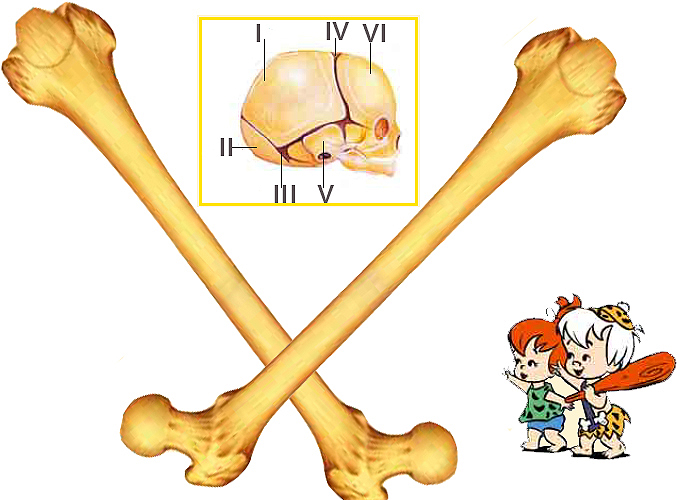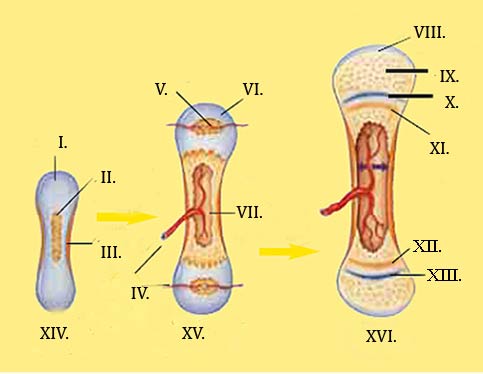Bigotry: The Dark Danger
Miracles in Our Bodies

DOWNLOAD THE BOOK
CHAPTERS OF THE BOOK
- Introduction
- A Giant Factory That is Not Seen with The Naked Eye: The Cell
- A Giant Network That Surrounds Our Bodies
- The Journey That The Food We Eat Makes in The Body
- The Blood’s Journey Through The Veins
- The Skeleton Composed of Bones
- Microscopic Motors of The Body: The Muscles
- The Air Conditioner Running Nonstop in Our Body
- Conclusion
< <
6 / total: 9
The Skeleton Composed of Bones
T here are 206 bones in our body. You may think that this is too many, but with the example we will give, you will understand how necessary it is to have that many bones. Let's consider the fingers. If each of your fingers consisted of only one bone, you would not be able to hold this book as you are doing now. This is because a stiff bone cannot be bent and will eventually break if you force it too hard. Since you would not be able to bend your fingers, you would not be able to grasp or catch hold of objects either. Neither would you be able to write or eat. What enables you to hold this book easily and maybe to drink your fruit juice at the same time is the existence of 27 interconnected bones, including those of your fingers, in your hand. As previously stated, there are 206 bones in our bodies, which are connected to each other like those in the hands. Each of these bones is situated in their places according to an intelligent plan. It is thanks to this perfect plan that you can bend your body forward, kneel and turn your head to the side. But make no mistake: you cannot do all these things just by using your bones, because bones cannot be bent. There are joints at the connection points of your bones. Thanks to these joints, you can easily bend your arm, raise your leg and use your fingers.
Let us give you an example in order to help you better understand how important joints are for the motion of our bones: Suppose that you made a wooden puppet. What should you do to move its arms? The arms of the puppet will surely not move unless you place a joint where the arms are connected to the shoulder. How will you make its legs movable then? You have to use an articulating piece again where its legs join the trunk. Only then can you move the wooden puppet's arms and legs. Likewise, if you separate the wood you have used for arms and legs into two pieces and place articulating pieces, or joints, between these pieces, then the puppet's arms and legs will also be bendable at the elbows and knees respectively. As may be clearly understood by this example, having many bones and joints placed between them where necessary enables us to move easily.
The Inimitable Properties of BonesThere are different types of joints between our bones. While some joints enable bones to move back and forth, others enable bones to move sideways. Now let's examine the joints and bones a little more closely. Our bones have undertaken the duties of carrying and protecting our bodies. Certainly, they are created capable and strong enough to perform these hard duties.
Our bones are light because they are interspersed with small holes like a honeycomb. But even though they are very light thanks to this porous structure, they are also very rigid. However this does not mean that they are fragile. On the contrary, they are so rigid that if you take the same amounts of bone and steel, they are 5 times stronger than steel. The thighbones in our legs, for example, have such an enormous capacity that they can lift a one ton load while standing upright. When you hop or jump from side to side, this bone is put under a weight corresponding to 3-4 times your body weight. However, you do not suffer any damage thanks to the firmness of your bones.
What makes bones so strong? In fact, the answer to this question is hidden in the matchless creation of bones, which we have briefly mentioned above. Bones are made of porous tissue like honeycomb. It is thanks to this structure that they are both very strong and light enough for easy use. Had it been otherwise, that is, if the inner parts of the bones had been rigid and did not have any spaces like the outer part, the bones would be too heavy. Furthermore, since they would not be elastic at all, you could have your bones broken or cracked with even the slightest of blows, say when you hit your arm lightly against the edge of a closet. However, Allah is All-Merciful and He created our bones so as to afford physical ease and protection.
What bones are made of has interested scientists a lot and they have tried to imitate bone tissue for years. This tissue, which is very strong, despite being very light, and which, most importantly, is capable of repairing itself, can grow on its own. The reason why your current body length is not the same as your length when you were 4-5 years old and why it will be different when you are 19-20 is the growth of your bones. Amazingly this growth is very well proportioned. Your arms grow while your legs grow; your fingers and toes grow harmoniously and the growth of each bone stops at an exact time. Furthermore, this does not happen only in your body but also in every healthy person's body. Everybody has bones possessing these characteristics. Scientists are conducting studies in order to produce a substance similar to the one that forms the bones in a human body. However, nobody has been able to develop a substance with such advanced characteristics as a bone has. It is thanks to the compassion of our Lord that our bones enable us to live our lives easily and to do a wide range of movements without difficulty and without suffering any pain. Bones That Maintain ThemselvesWe have explained that there are joints where bones are connected to each other. For example, we can bend and straighten out our arms and legs thanks to the joints located at our elbows and knees. Although they move throughout our lives, these joints never need to be lubricated. Machines, however, need regular maintenance. For example, you have to lubricate the pedals or the chain of your bicycle from time to time because the amount of oil is reduced as they are used, which consequently restricts motion. Likewise, the joints between your bones are used all the time, yet you never have to lubricate them. Why is that?
The answer to this question has been sought by scientists, who eventually discovered the following fact: in a joint, a tough, rubbery tissue called cartilage cushions the ends of the bones at contact points. There is a thin membrane lining the entire joint cavity which secretes a special fluid. As the bone exerts pressure on the joint, this fluid is forced out of the membrane and the joint becomes "lubricated". All these facts reveal to us that the human body is the result of an excellent design and superior creation. It is thanks to this excellent design that we can make many different movements easily and quickly. These features of the bones have been created by our Lord. Allah invites people to reflect on the creation of bones: ... Look at the bones—how We raise them up and clothe them in flesh... (Surat al-Baqara: 259) How Does a Broken Bone Heal?
As you have realised, all these tasks that are performed by bone cells, which are too small to be perceived by the naked eye, are signs of a superior intelligence. That is because cells do not have eyes to see with, yet they can build bones. Besides, they can understand when the space between the two broken pieces is filled and thus can decide when to stop. Then bone-dissolving cells notice that the newly built bone needs to be fashioned, and start reducing it. In order to do this, they use a strong acid to break down the bone, and give it the most appropriate form by applying this acid in smaller or greater quantities as necessary.
Acting as skillfully as a sculptor, our cells never go too far and cause harmful effects. They do not mistake the shapes and lengths of our bones. Furthermore, they flawlessly calculate when to multiply and when to stop. Think for a moment—what if your finger bones kept growing or your legs got longer and longer? That would be very terrifying, wouldn't it? But this never happens, and all of your bones lengthen exactly as they should. This is one of the clear proofs of the fact that your bone cells act by the inspiration of Allah. As you can see, all bone cells know very well what to do as well as how and where to do it. The system built for healing our bones works perfectly and enables bones to repair themselves. Scientists have admired this astonishing ability of bones for years. How did bone cells acquire such an amazing ability, which works totally without the awareness of the person concerned? How do cells know what they need to repair a broken bone and what actions to perform in order to heal it? While some of the cells have acquired the ability to build bones, others have taken on the duty of shaping them. Who assigned them their tasks? How come there is no disorder and how is it that each of them carries out its tasks at the exact moment it is required? Did bone cells learn all these things by themselves? Surely all these extraordinary tasks cannot be performed by some almost invisible cells' own volition. They could not possibly have learnt them by chance either. Acting by the inspiration of the All-Wise Allah, Who created them, our bone cells can give shape to bones like a skillful sculptor. Have you ever wondered how body cells form bones?The shapes of most of the 206 bones in your body are different from each other. This differentiation started when they first emerged, that is, when you were in your mother's womb. Cells, which were gradually increasing in number, took different forms as if each of them had been taught which part of the body it was supposed to constitute. Some cells branch off to form your bones, some to form your liver, some to form your kidneys and so yet others to form your eyes. But cells that will form the liver, bones or eyes do not merely gather together. They need to branch off even further. For example, bone cells should be aware of the location of the bone that they will form within the body. Then they should go to the correct place accordingly and take the correct form.
The bone cells in your feet act like a professional sculptor and form perfectly curved foot bones with the indentations and projections for the toes. As if they knew the size of the brain, the bone cells forming your skull build a smooth bony skeleton that perfectly encloses the brain. It is neither too small nor too big, so it neither squeezes the brain nor makes it difficult for you to hold your head high.
What is the source of the consciousness of cells, which gives perfect shapes to bones, knowing which form they should take and which tissue they should constitute? Our Lord inspires this delicate plan in them. Allah's supreme knowledge is pointed out in the following verses:
Everyone in the heavens and earth belongs to Him. All are submissive to Him. It is He Who originated creation and then regenerates it. That is very easy for Him. His is the most exalted designation in the heavens and the earth. He is the Almighty, the All-Wise.(Surat ar-Rum: 26-27)
|
||||||||||||||||||||||||||||||||||||||||||||||||||||||||
6 / total 9
You can read Harun Yahya's book Miracles in Our Bodies online, share it on social networks such as Facebook and Twitter, download it to your computer, use it in your homework and theses, and publish, copy or reproduce it on your own web sites or blogs without paying any copyright fee, so long as you acknowledge this site as the reference.


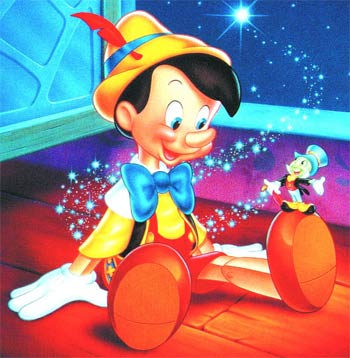
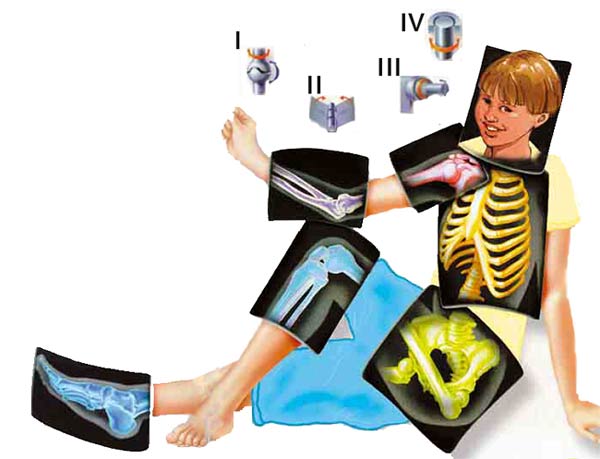





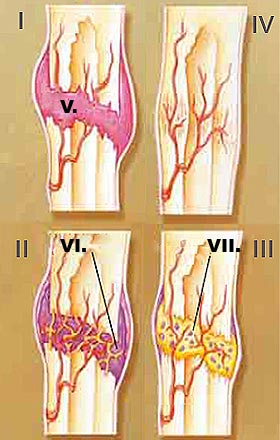
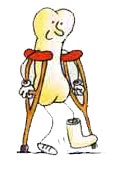 We have mentioned that bones are very rigid and strong. They may, however, be broken when they are exposed to severe blows. What happens then? The bone repairs itself. Doctors set the broken bone and make a plaster cast so that the bone knits correctly. There is nothing left for the doctors to do because the bone has its own repairing mechanism. It is miraculous that a broken bone heals itself and becomes even stronger than before. This miracle is worked as follows:
We have mentioned that bones are very rigid and strong. They may, however, be broken when they are exposed to severe blows. What happens then? The bone repairs itself. Doctors set the broken bone and make a plaster cast so that the bone knits correctly. There is nothing left for the doctors to do because the bone has its own repairing mechanism. It is miraculous that a broken bone heals itself and becomes even stronger than before. This miracle is worked as follows: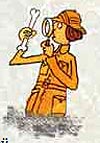 The blood surrounding the broken bone coagulates and forms a "haematoma", which is a large mass of clotted blood. This clot is a coating similar to the scab on your skin that occur following a cut. Minerals secreted by bone-building cells transform this clot into a rigid bone. Once this phase is completed, bone-dissolving cells come into play. Acting like a professional sculptor, these cells reduce the new bone with hydrochloric acid, which is a quite strong acid, and give a particular form to the bone. This process continues until the bone regains its original form. Even a year later, these bone-dissolving cells keep reducing the bone like diligent sculptors in order to shape it.
The blood surrounding the broken bone coagulates and forms a "haematoma", which is a large mass of clotted blood. This clot is a coating similar to the scab on your skin that occur following a cut. Minerals secreted by bone-building cells transform this clot into a rigid bone. Once this phase is completed, bone-dissolving cells come into play. Acting like a professional sculptor, these cells reduce the new bone with hydrochloric acid, which is a quite strong acid, and give a particular form to the bone. This process continues until the bone regains its original form. Even a year later, these bone-dissolving cells keep reducing the bone like diligent sculptors in order to shape it.

